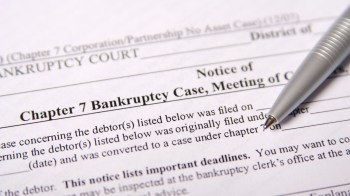On April 20, 2005, President George W. Bush signed the Bankruptcy Abuse Prevention and Consumer Protection Act into law. Record number of Americans had been filing for personal bankruptcy. The bill was meant to put more money into the hands of creditors, and crack down on filers. The idea behind the law change was that there had been a decline in the traditional stigma about declaring bankruptcy.
On the one-year anniversary of the bill signing, producer Sasha Aslanian and I aired an American Radio Works documentary that looked at the boom in bankruptcies, and the impact of the new law. Bankrupt: Maxed Out in America concluded that a decline in stigma–while real–wasn’t the critical force at work. Here’s our kicker:
Bankruptcy has long been the last legal option for anyone burdened with too much debt. But bankruptcy has always raised questions that go far beyond money. For society, the struggle is finding the right balance between honoring debts and a fresh start.
In 2005, lenders convinced Congress that too many people were going belly up. The lenders were right, but mostly for the wrong reasons. The social stigma traditionally attached to bankruptcy has eroded somewhat in recent decades. But that’s not what’s really driving the bankruptcy boom of the past quarter century. With heightened global competition, everyone faces increased job insecurity and earnings instability. And the modern credit economy, with its loose lending standards, is hazardous to the ill-informed or the unlucky.
As one bankruptcy authority in Memphis put it, Congress only made the bankruptcy door a little smaller and the process of going through that door a little meaner. But odds are the new bankruptcy law won’t succeed at closing that door altogether.
Now, Michelle J. White, economist at the University of California, San Diego and a leading expert on bankruptcy, has come out with a new study. We interviewed professor White for our documentary, and she offered up some of the most insightful comments we got while reporting. The abstract from her paper, Bankruptcy Reform and Credit Cards, summarizes the results of her research.
From 1980 to 2004, the number of personal bankruptcy filings in the United States increased more than five-fold, from 288,000 to 1.5 million per year. Lenders responded to the high filing rate with a major lobbying campaign for bankruptcy reform that led to the adoption in 2005 of the Bankruptcy Abuse Prevention and Consumer Protection Act (BAPCPA), which made bankruptcy law much less debtor-friendly. The paper first examines why bankruptcy rates increased so sharply. I argue that the main explanation is the rapid growth in credit card debt, which rose from 3.2% of U.S. median family income in 1980 to 12.5% in 2004. The paper then examines how the adoption of BAPCPA changed bankruptcy law. Prior to 2005, bankruptcy law provided debtors with a relatively easy escape route from debt, since credit card debt and other types of debt could be discharged in bankruptcy and even well-off debtors had no obligation to repay. BAPCPA made this escape route less attractive by increasing the costs of filing and forcing some high-income debtors to repay from post-bankruptcy income. However, because many consumers are hyperbolic discounters, making bankruptcy law less debtor-friendly will not solve the problem of consumers borrowing too much. This is because, when less debt is discharged in bankruptcy, lending becomes more profitable and lenders increase the supply of credit. The paper examines the determinants of an optimal bankruptcy law. It also considers the relationship between bankruptcy law and regulation of lending behavior and discusses proposals that would reduce lenders’ incentives to supply too much credit to debtors who are likely to become financially distressed.
It was a bad law.
There’s a lot happening in the world. Through it all, Marketplace is here for you.
You rely on Marketplace to break down the world’s events and tell you how it affects you in a fact-based, approachable way. We rely on your financial support to keep making that possible.
Your donation today powers the independent journalism that you rely on. For just $5/month, you can help sustain Marketplace so we can keep reporting on the things that matter to you.


















